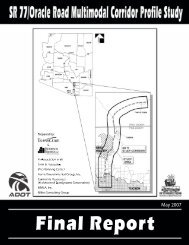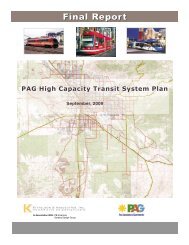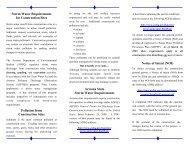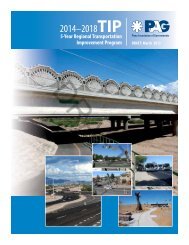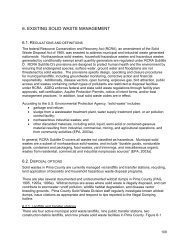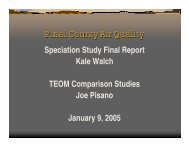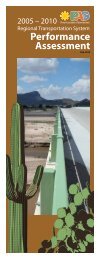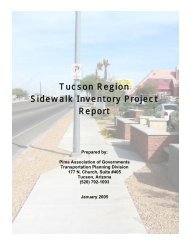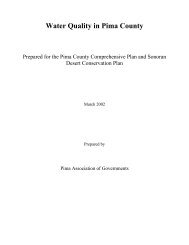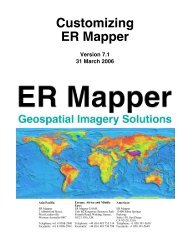Water Quality Requirements of Native Aquatic Species in Pima County
Water Quality Requirements of Native Aquatic Species in Pima County
Water Quality Requirements of Native Aquatic Species in Pima County
You also want an ePaper? Increase the reach of your titles
YUMPU automatically turns print PDFs into web optimized ePapers that Google loves.
<strong>Water</strong> <strong>Quality</strong> <strong>Requirements</strong><br />
<strong>of</strong> <strong>Native</strong> <strong>Aquatic</strong> <strong>Species</strong><br />
<strong>in</strong> <strong>Pima</strong> <strong>County</strong><br />
Prepared for the <strong>Pima</strong> <strong>County</strong> Comprehensive Plan and Sonoran<br />
Desert Conservation Plan<br />
March 2002<br />
Prepared By<br />
<strong>Pima</strong> Association <strong>of</strong> Governments
PIMA ASSOCIATION OF GOVERNMENTS<br />
REGIONAL COUNCIL<br />
Chair Vice-Chair Treasurer<br />
Zachery Freeland Paul Loomis Shirley Villegas<br />
Mayor Mayor Mayor<br />
Town <strong>of</strong> Sahuarita Town <strong>of</strong> Oro Valley City <strong>of</strong> South Tucson<br />
Member Member Member<br />
Ann Day Bobby Sutton Jr. Robert Walkup<br />
Supervisor Mayor Mayor<br />
<strong>Pima</strong> <strong>County</strong> Town <strong>of</strong> Marana City <strong>of</strong> Tucson<br />
Member<br />
Katie Dusenberry<br />
Member<br />
ADOT State Board Representative<br />
Management Committee<br />
Mike He<strong>in</strong>, Manager, Town <strong>of</strong> Marana<br />
Fernando Castro, Manager, City <strong>of</strong> South Tucson<br />
Charles Huckelberry, Adm<strong>in</strong>istrator, <strong>Pima</strong> <strong>County</strong><br />
James Keene, Manager, City <strong>of</strong> Tucson<br />
Chuck Sweet, Manager, Town <strong>of</strong> Oro Valley<br />
Jim Stahle, Manager, Town <strong>of</strong> Sahuarita<br />
Executive Director<br />
Thomas L. Swanson<br />
Environmental Plann<strong>in</strong>g Director<br />
Charles C. Matthewson<br />
<strong>Water</strong> <strong>Quality</strong> Plann<strong>in</strong>g Manager<br />
Greg Hess<br />
Senior <strong>Water</strong> <strong>Quality</strong> Planner <strong>Water</strong> <strong>Quality</strong> Planner Project Technical Assistant<br />
Claire L. Zucker Staffan Schorr Jason Bill<br />
Jean Boyce<br />
Support Staff<br />
Karen Baz<strong>in</strong>et<br />
Jacki Ontiveros<br />
January 2002
Acknowledgments<br />
PAG would like to thank Maeveen Behan and Julia Fonseca at <strong>Pima</strong> <strong>County</strong> for <strong>in</strong>clud<strong>in</strong>g this<br />
project <strong>in</strong> PAG’s work program and the <strong>Pima</strong> <strong>County</strong> Adm<strong>in</strong>istrator’s Office for provid<strong>in</strong>g the<br />
fund<strong>in</strong>g to make this project possible.<br />
In addition, PAG would like to thank the follow<strong>in</strong>g people who graciously provided <strong>in</strong>formation<br />
and <strong>in</strong>put <strong>in</strong> this project: Dr. L<strong>in</strong> Lawson and Kyle Palmer at Arizona Department <strong>of</strong><br />
Environmental <strong>Quality</strong>, Heidi Blasius at Arizona Game and Fish, Karen Sierra at <strong>Pima</strong> <strong>County</strong><br />
Wastewater Management Department, and Dr. Phil Rosen and Dr. Scott Bonar at the University<br />
<strong>of</strong> Arizona.
TABLE OF CONTENTS<br />
INTRODUCTION......................................................................................................................... 1<br />
BACKGROUND.............................................................................................................................. 1<br />
PURPOSE ...................................................................................................................................... 2<br />
LIMITATIONS................................................................................................................................2<br />
SPECIES ADDRESSED IN THIS REPORT .......................................................................................... 3<br />
GENERAL DISCUSSION OF WATER QUALITY................................................................. 5<br />
SPECIES-SPECIFIC WATER QUALITY STUDIES.............................................................. 7<br />
LONGFIN DACE ............................................................................................................................ 7<br />
GILA TOPMINNOW ....................................................................................................................... 9<br />
GILA CHUB ................................................................................................................................ 12<br />
DESERT PUPFISH ........................................................................................................................ 12<br />
DESERT SUCKER AND SONORA SUCKER..................................................................................... 13<br />
LEOPARD FROGS........................................................................................................................ 13<br />
STUDIES OF MULTIPLE SPECIES....................................................................................... 15<br />
SANTA CRUZ RIVER................................................................................................................... 15<br />
CAPTIVE POPULATIONS.............................................................................................................. 15<br />
ADDITIONAL WATER QUALITY DATA ............................................................................ 17<br />
SUMMARY AND CONCLUSIONS ......................................................................................... 19<br />
REFERENCES............................................................................................................................ 21<br />
iv
LIST OF TABLES<br />
TABLE 1. PRIORITY VULNERABLE AQUATIC SPECIES IN PIMA COUNTY ......................................... 3<br />
TABLE 2. MEAN CONCENTRATION OF METAL (MG/L) ADDED AS INORGANIC SALT AND PERCENT<br />
SURVIVAL (%) AT 96 HOURS OF JUVENILE AGOSIA CHRYSOGASTER EXPOSED TO TOXICANT<br />
LEVELS..................................................................................................................................... 7<br />
TABLE 3. 96 HOUR LETHAL CONCENTRATIONS OF HEAVY METALS IN MG/L, TO JUVENILE AGOSIA<br />
CHRYSOGASTER AND SLOPE FUNCTIONS OF RESPONSE CURVES TO THE SAME METALS ........... 8<br />
TABLE 4. SELECTED PARAMETERS FROM THE SANTA CRUZ RIVER ................................................ 9<br />
TABLE 5. ENVIRONMENTAL RANGES UNDER WHICH EXTANT POPULATIONS OF SONORAN<br />
TOPMINNOWS ARE FOUND. .................................................................................................... 11<br />
TABLE 6. CHEMICAL CONSTITUENTS IN WATER AT QUITOBAQUITO, ARIZONA............................ 13<br />
TABLE 7. SANTA CRUZ RIVER WATER QUALITY PARAMETERS, MAY 30, 1997............................ 15<br />
TABLE 8. SELECTED WATER QUALITY DATA FROM ADEQ DATABASE. ...................................... 18<br />
v
<strong>Water</strong> <strong>Quality</strong> <strong>Requirements</strong> <strong>of</strong> <strong>Native</strong> <strong>Aquatic</strong> <strong>Species</strong> <strong>in</strong> <strong>Pima</strong> <strong>County</strong><br />
Introduction<br />
Background<br />
S<strong>in</strong>ce 1998, <strong>Pima</strong> <strong>County</strong> has been work<strong>in</strong>g toward a comprehensive assessment <strong>of</strong> urban growth<br />
and the environment which has led to the creation <strong>of</strong> the Sonoran Desert Conservation Plan.<br />
Development <strong>of</strong> this plan has been prompted <strong>in</strong> part by the federal Endangered <strong>Species</strong> Act. In<br />
addition, the <strong>County</strong> is updat<strong>in</strong>g its Comprehensive Plan as required by the state’s recently<br />
adopted Grow<strong>in</strong>g Smarter legislation. The two plans will conta<strong>in</strong> a water quality element <strong>in</strong><br />
order to meet the requirements <strong>of</strong> the Grow<strong>in</strong>g Smarter legislation, and to ensure the preservation<br />
<strong>of</strong> species dependent on surface water or shallow groundwater <strong>in</strong> <strong>Pima</strong> <strong>County</strong>.<br />
<strong>Pima</strong> Association <strong>of</strong> Governments (PAG) is assist<strong>in</strong>g with the preparation <strong>of</strong> the <strong>Water</strong> <strong>Quality</strong><br />
Element at the <strong>County</strong>’s request. This request was prompted <strong>in</strong> part by the fact that PAG is the<br />
state-designated <strong>Water</strong> <strong>Quality</strong> Plann<strong>in</strong>g Agency for <strong>Pima</strong> <strong>County</strong> under Section 208 <strong>of</strong> the<br />
Clean <strong>Water</strong> Act.<br />
PAG's Section 208 <strong>Water</strong> <strong>Quality</strong> Management Plan consists <strong>of</strong> a document written <strong>in</strong> 1978 and<br />
all <strong>of</strong> the subsequent amendments and updates to that document. The 208 Plan addresses one <strong>of</strong><br />
the major water quality concerns associated with growth, which is the disposition <strong>of</strong> waste. The<br />
orig<strong>in</strong>al PAG 208 Plan and several amendments also identified various po<strong>in</strong>t- and non-po<strong>in</strong>t<br />
sources <strong>of</strong> pollutants. However, the 208 Plan has not had a recent comprehensive, countywide<br />
update and it does not <strong>in</strong>clude site-specific programs for unique aquatic habitats identified <strong>in</strong> the<br />
Sonoran Desert Conservation Plan. Therefore, reliance on the exist<strong>in</strong>g 208 Plan would probably<br />
not meet the <strong>County</strong>'s needs, and development <strong>of</strong> additional plann<strong>in</strong>g materials is warranted.<br />
This report attempts to identify the water quality requirements <strong>of</strong> aquatic species identified as<br />
priority species by the Sonoran Desert Conservation Plan. Used <strong>in</strong> conjunction with the two<br />
other water quality reports PAG prepared for the <strong>County</strong>’s plann<strong>in</strong>g effort, <strong>Water</strong> <strong>Quality</strong><br />
Summary and The <strong>Water</strong> <strong>Quality</strong> <strong>of</strong> Priority Streams <strong>in</strong> <strong>Pima</strong> <strong>County</strong>, this report could provide a<br />
tool for the <strong>County</strong> <strong>in</strong> its efforts to develop plans to protect these species. By know<strong>in</strong>g the<br />
quality <strong>of</strong> the various water sources <strong>in</strong> the <strong>County</strong> and the degree to which their quality is<br />
protected by law, and by compar<strong>in</strong>g these to the water quality requirements <strong>of</strong> aquatic species, it<br />
should be possible to determ<strong>in</strong>e which water sources would be appropriate for support<strong>in</strong>g the<br />
priority aquatic species identified <strong>in</strong> the Plan.<br />
1
Purpose<br />
The purpose <strong>of</strong> this report is to summarize what is known about the water quality requirements<br />
<strong>of</strong> priority vulnerable aquatic species identified <strong>in</strong> the <strong>Pima</strong> <strong>County</strong> Sonoran Desert Conservation<br />
Plan.<br />
Limitations<br />
The <strong>in</strong>formation provided <strong>in</strong> this report is limited entirely to data that were available from<br />
published literature and other agencies' monitor<strong>in</strong>g programs. PAG did not conduct any orig<strong>in</strong>al<br />
research for this project. Also, PAG's literature search was significantly constra<strong>in</strong>ed by time and<br />
resources. The literature used for this study was primarily that which was readily accessible<br />
from the University <strong>of</strong> Arizona library, local agency contacts (particularly <strong>Pima</strong> <strong>County</strong> Flood<br />
Control District, <strong>Pima</strong> <strong>County</strong> Wastewater Management Department, Arizona Department <strong>of</strong><br />
Environmental <strong>Quality</strong>, and Arizona Game and Fish Department), and the Internet. Additional<br />
<strong>in</strong>formation was probably available, but it was not <strong>in</strong>cluded <strong>in</strong> this report.<br />
An additional, important consideration is that this report does not address hydrologic factors<br />
affect<strong>in</strong>g aquatic habitat. Prelim<strong>in</strong>ary <strong>in</strong>dications from the <strong>County</strong>'s on-go<strong>in</strong>g <strong>Water</strong> <strong>Quality</strong><br />
Research Project suggest that physical characteristics <strong>of</strong> streams, such as flood frequency and<br />
streambed geology, are as important as water quality <strong>in</strong> determ<strong>in</strong><strong>in</strong>g which aquatic species are<br />
found <strong>in</strong> a stream.<br />
2
<strong>Species</strong> Addressed <strong>in</strong> this Report<br />
We reviewed and compiled exist<strong>in</strong>g data on the water quality requirements <strong>of</strong> the priority<br />
vulnerable aquatic species described <strong>in</strong> the SDCP (Table 1). In cases where data were very<br />
limited, available studies <strong>in</strong>volv<strong>in</strong>g closely related species were used as well.<br />
Table 1. Priority Vulnerable <strong>Aquatic</strong> <strong>Species</strong> <strong>in</strong> <strong>Pima</strong> <strong>County</strong> (<strong>Pima</strong> <strong>County</strong>, 2000a)<br />
<strong>Species</strong><br />
Location<br />
Chiricahua Leopard Frog (Rana chiricahuensis)<br />
Middle San Pedro,<br />
Lowland Leopard Frog (Rana yavapaiensis)<br />
Cienega-R<strong>in</strong>con,<br />
Altar Valley, and the<br />
Middle Santa Cruz<br />
watershed subareas.<br />
Longf<strong>in</strong> Dace (Agosia chrysogaster)<br />
Desert Sucker (Catostomus clarki)<br />
Sonora Sucker (Catostomus <strong>in</strong>signis)<br />
Desert Pupfish (Cypr<strong>in</strong>odon macularius macularius)<br />
Gila Chub (Gila <strong>in</strong>termedia)<br />
Gila Topm<strong>in</strong>now (Poeciliopsis occidentalis)<br />
Middle San Pedro,<br />
Cienega-R<strong>in</strong>con,<br />
Altar Valley, and the<br />
Middle Santa Cruz<br />
watershed subareas<br />
3
General Discussion <strong>of</strong> <strong>Water</strong> <strong>Quality</strong><br />
Little <strong>in</strong>formation was readily available on the specific water quality requirements <strong>of</strong> the aquatic<br />
species targeted by this study. Most studies we found were limited <strong>in</strong> scope. This is significant,<br />
because toxicity test<strong>in</strong>g <strong>in</strong> aquatic environments is highly complex, due to the vary<strong>in</strong>g effects <strong>of</strong><br />
hydrologic conditions, and the <strong>in</strong>terrelationships between, and comb<strong>in</strong>ed effects <strong>of</strong>, multiple<br />
water quality constituents.<br />
<strong>Water</strong> quality factors generally associated with the health <strong>of</strong> streams and rivers, as well as fish<br />
survival rates, <strong>in</strong>clude the chemical characteristics <strong>of</strong> pH, buffer<strong>in</strong>g capacity, dissolved oxygen<br />
and nutrient levels. They also <strong>in</strong>clude physical characteristics such as stream width, temperature,<br />
substrate, water velocity, and volume. Several detailed studies have been done, but <strong>in</strong> general<br />
we need more data to establish mean<strong>in</strong>gful water quality standards for fish and frogs <strong>in</strong> the<br />
Southwest.<br />
Along these l<strong>in</strong>es, <strong>Pima</strong> <strong>County</strong> Wastewater Management Department is conduct<strong>in</strong>g a major<br />
study on water quality: The Arid West <strong>Water</strong> <strong>Quality</strong> Research Project (WQRP). The objective<br />
<strong>of</strong> the WQRP is to determ<strong>in</strong>e whether exist<strong>in</strong>g federal and state standards for wastewater<br />
discharges to ephemeral streams need modification or if a new set <strong>of</strong> standards needs to be<br />
developed specifically to protect effluent-dependent aquatic and riparian habitat <strong>in</strong> the arid west.<br />
The scope <strong>of</strong> the project covers seven states and looks at 10 study sites. (<strong>Pima</strong> <strong>County</strong><br />
Wastewater Management Department, 2001).<br />
In contrast to the lack <strong>of</strong> data for the species listed <strong>in</strong> Table 1, there are large amounts <strong>of</strong> data on<br />
aquatic <strong>in</strong>vertebrates and the impairment factors that affect their communities. <strong>Aquatic</strong><br />
<strong>in</strong>vertebrates are worms and <strong>in</strong>sects like mayflies, stoneflies, and caddisflies that live <strong>in</strong> water.<br />
These animals are sensitive to water quality degradation and are more abundant <strong>in</strong> good quality<br />
streams. Therefore, they are useful <strong>in</strong> determ<strong>in</strong><strong>in</strong>g the relative quality <strong>of</strong> the water (USGS,<br />
2000). Macro<strong>in</strong>vertebrates are good <strong>in</strong>dicators <strong>of</strong> localized conditions because they are sensitive<br />
to their environment and relatively immobile (Lawson, 1995).<br />
<strong>Water</strong> quality is affected by many factors. Riparian environments <strong>in</strong>fluence the physical and<br />
chemical characteristics <strong>of</strong> streams and are essential <strong>in</strong> the health <strong>of</strong> the waterbody. In higher<br />
reaches streamside trees provide shade that helps the water ma<strong>in</strong>ta<strong>in</strong> a cool temperature, thereby<br />
<strong>in</strong>creas<strong>in</strong>g the stream's oxygen-carry<strong>in</strong>g capacity. Also, the roots <strong>of</strong> these trees stabilize stream<br />
banks, reduc<strong>in</strong>g erosion and slow<strong>in</strong>g down run<strong>of</strong>f, allow<strong>in</strong>g sediments to settle out (Boquet River<br />
Association, 2001). The middle reaches <strong>of</strong> smaller streams <strong>in</strong> the Southwest that flow from<br />
higher elevations tend to be narrow, but widen somewhat as they reach valley floors before<br />
<strong>in</strong>filtrat<strong>in</strong>g <strong>in</strong>to streambeds (Lawson, 2002).<br />
Arizona Game and Fish Department stated that they typically monitor water that native fish<br />
<strong>in</strong>habit for four basic water quality parameters throughout the year: pH, conductivity, dissolved<br />
oxygen and temperature (Blasius, 2001). The pH <strong>of</strong> a water <strong>in</strong>dicates its degree <strong>of</strong> alkal<strong>in</strong>ity or<br />
acidity. A pH <strong>of</strong> 7.0 <strong>in</strong>dicates a water that is neither acidic nor alkal<strong>in</strong>e. Natural, unpolluted<br />
waterbodies <strong>in</strong> southeastern Arizona are naturally alkal<strong>in</strong>e and generally have a pH <strong>in</strong> the range<br />
<strong>of</strong> 6.9-8.6. Extreme pH values (high or low) can lead to the development <strong>of</strong> conditions that can<br />
5
e toxic to aquatic life. Changes <strong>of</strong> pH <strong>in</strong> a waterbody can be due to chemical, physical or<br />
biological processes. Most aquatic organisms have an optimum pH range <strong>of</strong> 6.5-8.5 (Lawson,<br />
1995).<br />
Conductivity, or specific electrical conductance (EC), is a measurement <strong>of</strong> the ability <strong>of</strong> water to<br />
carry an electric current. This ability depends on the presence <strong>of</strong> ions, their concentration, and<br />
the temperature. The conductivity <strong>of</strong> distilled water is <strong>in</strong> the range <strong>of</strong> 0.5-3.0 µmhos/cm, potable<br />
water is generally 50-1500 µmhos/cm, and some <strong>in</strong>dustrial wastewaters can have conductivities<br />
over 10,000 µmohs/cm. S<strong>in</strong>ce EC is an <strong>in</strong>direct measurement <strong>of</strong> the concentration <strong>of</strong> total<br />
dissolved solids <strong>in</strong> a solution, it can be used as an <strong>in</strong>dicator <strong>of</strong> pollution problems <strong>in</strong> some cases<br />
(Lawson, 1995; Standard Methods, 1998). However, many waterbodies are naturally high <strong>in</strong><br />
TDS.<br />
Dissolved oxygen (D.O.) is necessary to all aquatic organisms that need oxygen for life<br />
processes. The solubility <strong>of</strong> oxygen <strong>in</strong> water depends on water temperature and air pressure.<br />
Because <strong>of</strong> this, warm water or water at high elevations cannot carry as much D.O. as cold water<br />
or water at lower elevations. Dissolved oxygen <strong>in</strong> water comes from the atmosphere, surface<br />
turbulence, and photosynthesis by aquatic plants. <strong>Water</strong>s that have consistently high D.O. are<br />
considered healthy. D.O. concentrations <strong>in</strong> unpolluted, southeast Arizona waters typically range<br />
from 7.5-8.3 mg/l. The State <strong>of</strong> Arizona has set water quality standards for D.O. as m<strong>in</strong>imum<br />
numerical concentration limits or 90% dissolved oxygen saturation. In the Santa Cruz River,<br />
south <strong>of</strong> <strong>Pima</strong> <strong>County</strong>, at one spr<strong>in</strong>gflow sampl<strong>in</strong>g site the water was found to be rout<strong>in</strong>ely 15-<br />
30% below saturation. Spr<strong>in</strong>gflow is typically low <strong>in</strong> D.O. and the fish and aquatic <strong>in</strong>sects liv<strong>in</strong>g<br />
at this site did not show signs <strong>of</strong> stress from the D. O. levels (Lawson, 1995).<br />
Temperature read<strong>in</strong>gs are used <strong>in</strong> the calculation <strong>of</strong> various forms <strong>of</strong> alkal<strong>in</strong>ity, calculation <strong>of</strong><br />
sal<strong>in</strong>ity and <strong>in</strong> general laboratory operations. <strong>Water</strong> temperatures generally closely follow air<br />
temperatures, and data imply that temperature dependent processes (chemical, physical, and<br />
biological) may be very dynamic (Lawson, 1995; Standard Methods, 1998).<br />
Additional water quality constituents <strong>of</strong> potential concern <strong>in</strong>clude nutrients (nitrogen and<br />
phosphorus), pesticides, trace metals, and polycyclic aromatic hydrocarbons (PAHs) (Liston and<br />
Maher, 1997). High levels <strong>of</strong> nutrients can lead to eutrophication <strong>of</strong> aquatic environments, while<br />
pesticides, trace metals, and PAHs can be toxic to aquatic life. One form <strong>of</strong> nitrogen, ammonia<br />
(NH3), is also toxic. For example, ammonia is the major stressor <strong>of</strong> aquatic species below the<br />
Nogales Wastewater Treatment Plant on the upper Santa Cruz River.<br />
6
<strong>Species</strong>-Specific <strong>Water</strong> <strong>Quality</strong> Studies<br />
Longf<strong>in</strong> Dace<br />
Lewis (1978) looked at the effects <strong>of</strong> m<strong>in</strong><strong>in</strong>g wastes <strong>in</strong> streams and the acute toxicity <strong>of</strong> heavy<br />
metals <strong>in</strong> water on native fish species. A series <strong>of</strong> toxicity tests were conducted on juvenile<br />
longf<strong>in</strong> dace (Agosia chrysogaster) <strong>in</strong> hard water us<strong>in</strong>g copper, z<strong>in</strong>c, manganese, and copperz<strong>in</strong>c<br />
and copper-manganese mixtures. The results <strong>in</strong>dicate that the longf<strong>in</strong> dace is more sensitive<br />
to z<strong>in</strong>c and slightly less sensitive to copper than the commonly studied fathead m<strong>in</strong>now. The<br />
longf<strong>in</strong> dace appears to be more resistant to manganese than juvenile trout. It was shown that<br />
metals <strong>in</strong> comb<strong>in</strong>ation generally exhibit additive toxicity, with the copper-z<strong>in</strong>c solutions be<strong>in</strong>g<br />
more toxic than any s<strong>in</strong>gle-metal solution. The results are shown on Tables 2 and 3.<br />
Table 2. Mean Concentration <strong>of</strong> Metal (mg/l) added as <strong>in</strong>organic salt and percent survival<br />
(%) at 96 hours <strong>of</strong> juvenile Agosia chrysogaster exposed to toxicant levels. Values represent<br />
the mean <strong>of</strong> each test and replicate (Lewis, 1978).<br />
Cu (mg/l) Zn (mg/l) Mn (mg/l) Cu-Zn (mg/l) Cu-Mn (mg/l)<br />
20.4 (0%) 25.5(0%) 436 (0%) 20.0-23.0 (0%) 20.5-430 (0%)<br />
4.0 (0%) 4.4 (0%) 269 (0%) 3.5-4.0 (0%) 3.4-219 (0%)<br />
1.8 (0%) 2.4 (0%) 150 (0%) 2.0-2.3 (0%) 2.0-171 (0%)<br />
1.3 (30%) 0.5 (60%) 84 (60%) 0.3-0.6 (0%) 0.8-100 (0%)<br />
0.3 (80%) 0.3 (90%) 56 (90%) 0.2-0.4 (40%) 0.2-28 (80%)<br />
0.1-0.2 (100%) 0.1-14 (100%)<br />
7
Table 3. 96 Hour Lethal Concentrations <strong>of</strong> Heavy Metals <strong>in</strong> mg/l, to Juvenile Agosia<br />
chrysogaster and Slope Functions <strong>of</strong> Response Curves to the Same Metals (Lewis, 1978).<br />
Metal ° C pH DO*<br />
mg/l<br />
Total<br />
hardness<br />
mg/l **<br />
Test<br />
organisms<br />
exposed<br />
Lethal<br />
Concentration<br />
‡<br />
Copper 19.3 7.7 9.5 221 100 0.86<br />
(0.7-1.1)<br />
Z<strong>in</strong>c 18.9 7.8 9.3 217 100 0.79<br />
(0.4-1.5)<br />
Manganese 19.0 7.6 8.7 224 100 130<br />
(100-169)<br />
Copper-<br />
Z<strong>in</strong>c<br />
Copper-<br />
Manganese<br />
18.7 7.8 8.9 219 100 0.21<br />
(0.15-0.29)<br />
0.28<br />
(0.18-0.45)<br />
19.5 8.0 9.0 231 100 0.45<br />
(0.31-0.64)<br />
64.0<br />
(47-88)<br />
Slope<br />
function<br />
†<br />
1.53<br />
* Experimental Conditions<br />
** as CaCo3<br />
‡ Number shown is 96-L.C. 50, which <strong>in</strong>dicates the lethal concentration at which 50% <strong>of</strong> the test<br />
organisms died after a 96 hour test. Values <strong>in</strong>clude background concentrations <strong>in</strong> dilution water (mg/l):<br />
Cu-0.02, Zn-0.001, and Mn- 0.004. Numbers <strong>in</strong> () <strong>in</strong>dicate 95% confidence limits.<br />
†Values <strong>in</strong>dicate variation <strong>of</strong> response <strong>of</strong> the test population to the poison.<br />
2.86<br />
1.50<br />
1.78<br />
2.14<br />
1.79<br />
1.75<br />
Extensive monitor<strong>in</strong>g <strong>of</strong> the Upper Santa Cruz River was conducted <strong>in</strong> the early 1990’s. The<br />
most common fish <strong>in</strong> the river is the longf<strong>in</strong> dace, which is also the most abundant native<br />
m<strong>in</strong>now <strong>in</strong> Arizona’s low elevation streams. The study, completed by ADEQ and volunteers,<br />
was conducted to document fish species occurrence and to determ<strong>in</strong>e if there were any<br />
environmental factors adversely affect<strong>in</strong>g fish <strong>in</strong> the effluent dependant reach <strong>of</strong> the river.<br />
<strong>Water</strong> quality <strong>in</strong> the study area was generally considered good. Metals concentrations did not<br />
appear to have a negative effect on aquatic life. Nutrients added to the river through the<br />
wastewater treatment plant discharges dim<strong>in</strong>ished downstream. This species, Agosia<br />
chrysogaster, is tolerant <strong>of</strong> high water temperatures, low D.O. (as low as 1.0 mg/l for short<br />
periods) and is able to gulp air when low D.O. conditions are present (Lawson, 1995). This fish<br />
was found <strong>in</strong> the greatest density at the control site (above the treatment plant) and at the sample<br />
location farthest downstream. Selected water quality data are shown on Table 4.<br />
8
Table 4. Selected Parameters from the Santa Cruz River—Guevavi Ranch Control<br />
Site, Upstream from the Nogales International Wastewater Treatment Plant<br />
(Lawson, 1995)<br />
Date<br />
Sampled<br />
Temp<br />
<strong>Water</strong><br />
( °C)<br />
DO<br />
(mg/l)<br />
EC<br />
(field)<br />
(µmhos<br />
/cm)<br />
pH<br />
(field)<br />
TDS<br />
(mg/l)<br />
TSS<br />
(mg/l)<br />
Turbidity<br />
(NTU)<br />
Total<br />
Alkal<strong>in</strong>ity<br />
(mg/l)<br />
Total<br />
Phosphate<br />
(mg/l)<br />
11/20/92 14.5 N/A 404 7.78 277 4 0.03 160 0.091 0.44<br />
12/16/92 18.5 N/A N/A 7.59 281 2 0.20 151 0.067 0.63<br />
02/03/93 10 8.2 309 8.16 228 295 23 106 0.388 0.54<br />
02/23/93 8.5 9.60 251 7.68 166 180 39 83.0 0.32 0.33<br />
03/31/93 17.0 N/A 354 8.05 251 39 20 148 0.19 0.4<br />
04/28/93 21.5 9.7 388 7.86 220 4 0.66 132 0.19 0.41<br />
05/11/93 15.5 7.55 354 7.79 225 4 0.54 134 0.15 0.26<br />
06/23/93 12.0 6.89 380 7.71 201 4 0.32 144 0.05 0.28<br />
07/21/93 16.0 6.95 354 7.76 233 4 0.39 138 0.18 0.31<br />
08/19/93 18.5 6.55 347 7.76 230 4 0.50 142 0.11 0.24<br />
09/08/93 16.0 6.1 373 7.39 230 4 0.52 143 0.092 0.30<br />
10/13/93 13.5 6.4 380 7.61 230 10 0.48 157 0.13 0.42<br />
Nitrate<br />
(mg/l)<br />
Gila Topm<strong>in</strong>now<br />
The Gila topm<strong>in</strong>now (Poeciliopsis occidentalis) favors a habitat <strong>of</strong> shallow, warm, quiet waters<br />
<strong>in</strong> perennial and <strong>in</strong>termittent streams, marshes and riverbanks where there are dense mats <strong>of</strong><br />
algae and debris and sandy substrate (Matthews, 1990). Though more <strong>in</strong>formation is needed on<br />
the specific water quality components <strong>of</strong> the fish’s preferred environment, their temperature<br />
range is known to extend from near freez<strong>in</strong>g under ice to 37 °C, with a maximum tolerance <strong>of</strong> 43<br />
°C for brief periods. Topm<strong>in</strong>nows can live <strong>in</strong> a fairly wide range <strong>of</strong> water chemistries, with<br />
recorded values <strong>of</strong> pH from 6.6-8.9, dissolved oxygen read<strong>in</strong>gs from 2.2 to 11 mg/l and sal<strong>in</strong>ities<br />
from very dilute to seawater. It has been reported that they can tolerate almost total loss <strong>of</strong> water<br />
by burrow<strong>in</strong>g <strong>in</strong>to the mud for 1-2 days (Weedman, 1998).<br />
The biggest threats to this species are habitat destruction and the <strong>in</strong>troduction <strong>of</strong> non-native<br />
species (Weedman, 1998). M<strong>in</strong>ckley (1999) conducted a study for a recovery program for the<br />
Gila topm<strong>in</strong>now. This study noted that the reasons for the disappearance <strong>of</strong> the Gila topm<strong>in</strong>now<br />
from 96 locations was apparent: 57 were desiccated, 27 were lost to flood<strong>in</strong>g, 6 to w<strong>in</strong>ter cold<br />
and 1 or 2 to mosquit<strong>of</strong>ish, water quality, dredg<strong>in</strong>g or livestock overuse.<br />
An early study <strong>of</strong> topm<strong>in</strong>now by Meffe and others (1983), showed that the steady decl<strong>in</strong>e <strong>of</strong> this<br />
species is correlated with and primarily attributed to habitat destruction and the <strong>in</strong>troduction and<br />
9
establishment <strong>of</strong> mosquit<strong>of</strong>ish and other exotic fishes. Between August 1979 and July 1981 all<br />
known populations <strong>of</strong> what was called the Sonoran topm<strong>in</strong>now were visited from one to 10<br />
times. Several environmental parameters were measured at all sites. The m<strong>in</strong>imum and<br />
maximum values <strong>of</strong> the environmental parameters encountered by P. occidentalis are presented<br />
on Table 5. The author considered these ranges to be a m<strong>in</strong>imum <strong>of</strong> those tolerable to this<br />
species as these are considered “remnant habitats <strong>of</strong> a formerly wide-rang<strong>in</strong>g fish…”<br />
(Meffe, et al., 1983).<br />
The Sonoran topm<strong>in</strong>now was formerly considered to have two subspecies: the Gila topm<strong>in</strong>now<br />
( P.o. occidentalis) and the Yaqui topm<strong>in</strong>now (P.o. sonorensis). They are now considered to be<br />
two species with only the Gila topm<strong>in</strong>now (P.occidentalis) occurr<strong>in</strong>g <strong>in</strong> <strong>Pima</strong> <strong>County</strong> (<strong>Pima</strong><br />
<strong>County</strong>, 2001). Natural populations <strong>of</strong> the Gila topm<strong>in</strong>now are found <strong>in</strong> some areas <strong>of</strong> the upper<br />
Santa Cruz River but are not found <strong>in</strong> the lower, effluent dom<strong>in</strong>ated portion <strong>of</strong> the Santa Cruz.<br />
10
Table 5. Environmental Ranges under Which Extant Populations <strong>of</strong> Sonoran Topm<strong>in</strong>nows are Found. From: Factors Result<strong>in</strong>g <strong>in</strong><br />
Decl<strong>in</strong>e <strong>of</strong> the Endangered Sonoran Topm<strong>in</strong>now Poeciliopsis occidentalis (Ather<strong>in</strong>iformes: Poeciliidae) <strong>in</strong> the United States. By Meffe,<br />
Hendrickson, and M<strong>in</strong>ckley (1983).<br />
Site<br />
Temp<br />
(°C)<br />
O2<br />
(mg/l)<br />
Conductivity<br />
(umhos)<br />
Alkal<strong>in</strong>ity<br />
Total<br />
(meq/l)<br />
pH<br />
Cl<br />
(mg/l)<br />
S04-S<br />
(mg/l)<br />
Si<br />
(mg/l)<br />
No3-N<br />
(mg/l)<br />
Soluble<br />
reactive<br />
Phosphate<br />
(mg/l)<br />
Total<br />
Dissolved<br />
Phosphate<br />
(mg/l)<br />
Monkey 26.5- 2.4 990-1200 1.1-5.0 6.9*-7.6 4.0*- 81.1- 1.3-3.7 0.09-0.32 0.00-0.04 0.002-0.096<br />
Spr<strong>in</strong>g 27.5<br />
8.8 *563.0<br />
Cottonwood 26.0- - 1200-1350 3.3* 6.9* 6.8 73.5 2.9 0.02-0.28 0.00-0.10 0.001-0.16<br />
Spr<strong>in</strong>g 31.0<br />
Sheehy 6.0- 4.5- 290-520 3.3 6.9-8.9 6.4-7.6 0.0-0.1 3.2-5.2 0.00-0.09 0.00-0.04 0.005-0.098<br />
Spr<strong>in</strong>g 20.0 7.3<br />
Unnamed 7.0- 2.7- 290-540 3.0-5.9 7.4-8.8 2.2- 0.3-25.0 3.4-5.7 0.01-0.03 0.00-0.06 0.014-0.12<br />
Spr<strong>in</strong>g 26.8 6.1<br />
15.2<br />
Santa Cruz 23.5 - 300 - 8.2 7.3 13.1 2.7 0.00-0.01 0.016-0.019 0.02-0.04<br />
River<br />
Redrock 14-24 - 1200-2300 2.8-3.3 7.4-8.5 - - - - - -<br />
Canyon<br />
Cienega 10.5- - 470-535 4.0 - 8.8 18.3 4.0 0.00-0.01 0.002 0.001-0.003<br />
Creek 22<br />
Cocio Wash 22-29 8-11 1099-2210 3.8-5.6 7.5-7.6 - - - - - -<br />
Bylas 17.0- 3.0- 1350-5050 2.0-3.4 6.6-8.5 8.5 26.1-52.3 4.4- 0.00-1.1 0.00-0.02 0.001-0.025<br />
Spr<strong>in</strong>gs 36.7 9.0<br />
11.1<br />
San 11.7- 6.8 540-680 3.4 7.6-8.5 14.2 16.7 4.6 0.02 0.12 0.17<br />
Bernad<strong>in</strong>o<br />
Creek<br />
32.0<br />
Artesian 22.0- 2.2- 390-500 3.7-4.0 7.2-8.6 8.2-9.5 5.6-9.2 4.0-4.9 0.64-1.3 0.003-0.076 0.003-0.083<br />
Wells 29.1 8.1<br />
Mesa Spr<strong>in</strong>g 18.2- 2.2 - - - - - - - - -<br />
23.0<br />
Leslie Creek 12.7- - 620-660 - 7.3-7.6 6.8 36.0 5.7 6.2-8.3 0.00-0.02 0.001-0.016<br />
21.0<br />
Sonoita - - 515-1000 4.2 7.0-7.8 10.1 36.0 5.5 0.00-0.01 0.009-0.024 0.006-0.034<br />
Creek<br />
If more than one read<strong>in</strong>g for any parameter was available, then m<strong>in</strong>imum and maximum values are presented. Otherwise the s<strong>in</strong>gle<br />
available figure is given. *= from Schoenherr, 1974.<br />
11
Gila Chub<br />
The Gila chub (Gila <strong>in</strong>termedia) is <strong>of</strong>ten associated with cienegas and deep pools <strong>in</strong> smaller<br />
headwater streams provided with dense vegetative cover. Dur<strong>in</strong>g the day it spends its time under<br />
the cover <strong>of</strong> cutbanks, vegetative overhang or aquatic vegetation (Adams, no date). Habitatspecific<br />
water quality data are not readily available. The BLM has identified reaches <strong>of</strong> Cienega<br />
Creek occupied by the Gila chub. They <strong>in</strong>habit portions <strong>of</strong> seven stream miles <strong>of</strong> approximately<br />
24 miles <strong>of</strong> stream above Interstate 10. The status <strong>of</strong> the Gila chub <strong>in</strong> this area is considered<br />
stable and secure. The population is believed to be healthy, and pool habitat is stable with<br />
m<strong>in</strong>imal threat <strong>of</strong> non-native species <strong>in</strong>troduction (Weedman, 1996).<br />
Arizona Game and Fish recommends that all exist<strong>in</strong>g Gila chub populations be identified,<br />
protected, and monitored. They believe that reduction <strong>of</strong> land erosion, preservation <strong>of</strong> habitat,<br />
and stream improvement structures on some sites could benefit Gila chub populations. Also, the<br />
removal <strong>of</strong> nonnative fish species from historic habitat areas, such as lower Sab<strong>in</strong>o Canyon, will<br />
<strong>in</strong>crease the survival rates <strong>of</strong> vulnerable juveniles. Habitats critical to their survival <strong>in</strong>clude<br />
cienegas, headwaters, spr<strong>in</strong>g-fed streams, and spr<strong>in</strong>g-fed ponds that are free <strong>of</strong> non-native<br />
species (Weedman, 1996).<br />
Desert Pupfish<br />
Accord<strong>in</strong>g to U.S. Fish and Wildlife Service <strong>in</strong> the Desert Pupfish Recovery Plan, “the desert<br />
pupfish (Cypr<strong>in</strong>odon macularius) occupied a diversity <strong>of</strong> habitats rang<strong>in</strong>g from cienegas and<br />
spr<strong>in</strong>gs to small streams and marg<strong>in</strong>s <strong>of</strong> larger bodies <strong>of</strong> water. Most habitats were shallow and<br />
had s<strong>of</strong>t substrates and clear water.” It is also noted that the pupfish can survive under<br />
conditions <strong>of</strong> very high water temperatures (to 45°C), low dissolved oxygen (concentrations <strong>of</strong><br />
0.1-0.4 mg/l) and high sal<strong>in</strong>ity (concentrations twice that <strong>of</strong> seawater). They can also survive<br />
abrupt changes <strong>in</strong> temperature and sal<strong>in</strong>ity that would be lethal to other fish species. In<br />
environments with other species the pupfish typically occupies shallower water than adults <strong>of</strong> the<br />
other species (Marsh and Sada, 1993).<br />
In <strong>Pima</strong> <strong>County</strong> a large population <strong>of</strong> pupfish, C. macularius eremus, is endemic to Quitobaquito<br />
Spr<strong>in</strong>gs (Miller and Fuiman, 1987). Some water quality data are available for the pond and the<br />
spr<strong>in</strong>g; the data are shown on Table 6.<br />
12
Table 6. Chemical Constituents <strong>in</strong> <strong>Water</strong> at Quitobaquito, Arizona. From Description and<br />
Conservation Status <strong>of</strong> Cypr<strong>in</strong>odan macularius eremus. A New Subspecies <strong>of</strong> Pupfish from<br />
Organ Pipe Cactus National Monument, Arizona. Miller and Fuiman, 1987.<br />
*Parameter<br />
Quitobaquito<br />
Pond, 1982<br />
Quitobaquito<br />
Pond, 1963, 1964<br />
Quitobaquito<br />
Spr<strong>in</strong>g, 1982<br />
Quitobaquito<br />
Spr<strong>in</strong>g, 1963-64<br />
TDS 820 670<br />
TSS
flood<strong>in</strong>g, alteration <strong>of</strong> riparian habitat by livestock graz<strong>in</strong>g, destruction <strong>of</strong> <strong>in</strong>-stream habitats, and<br />
the <strong>in</strong>troduction <strong>of</strong> non-native, predatory fish, crayfish and bullfrogs (<strong>Pima</strong> <strong>County</strong>, 2001).<br />
The Chiricahua leopard frogs’ habitat <strong>in</strong>cludes rocky streams with deep rocky pools, overflow<br />
pools and oxbows <strong>of</strong> rivers, permanent spr<strong>in</strong>gs, ponds, and wetlands. It also utilizes stock tanks,<br />
wells, and ma<strong>in</strong>stream river reaches. Ideal habitat <strong>in</strong>cludes permanent water dur<strong>in</strong>g breed<strong>in</strong>g<br />
season, deep pools with nearby shallow areas, undercut banks, overhang<strong>in</strong>g terrestrial vegetation,<br />
and aquatic vegetation, which might not be present <strong>in</strong> streams experienc<strong>in</strong>g sediment pollution.<br />
While the species can use a variety <strong>of</strong> aquatic habitats, generally perennial streams and spr<strong>in</strong>gs<br />
are the most important. Potential threats to this species are <strong>in</strong>troduced pest species, loss <strong>of</strong><br />
habitat result<strong>in</strong>g from water diversion, sediment pollution, groundwater pump<strong>in</strong>g, pollution, and<br />
anoxia (<strong>Pima</strong> <strong>County</strong>, 2001).<br />
PAG found no <strong>in</strong>formation on water quality requirements for Rana chiricahuensis or Rana<br />
yavapaiensis. However, we found one study <strong>of</strong> the effects <strong>of</strong> nitrate and nitrite solutions on<br />
newly hatched larvae <strong>of</strong> five species <strong>of</strong> pond-breed<strong>in</strong>g amphibians from the Pacific Northwest:<br />
Rana pretiosa, Rana aurora, Bufo boreas, Hyla regilla, and Ambystoma gracile. The ranid<br />
species had acute effects <strong>in</strong> water with nitrite. All species showed high mortality at 5 mg/l<br />
nitrite-N and significant larval mortality at 1 mg/l nitrite-N. Nitrate at 90 mg/l as N was highly<br />
toxic for R. pretiosa and A. gracile larvae (Marco et al.,1999).<br />
We also found a study <strong>of</strong> decl<strong>in</strong><strong>in</strong>g populations <strong>of</strong> Tarahumara frog (Rana tarahumarae) <strong>in</strong><br />
southern Arizona and northern Mexico (Hale et al., 1995). The authors noted that populations <strong>of</strong><br />
Chiricahua leopard frogs (Rana chiricahuensis) and Yavapai leopard frogs (R. yavapaiensis)<br />
decl<strong>in</strong>ed with the Tarahumara frog where they occurred together. The causes <strong>of</strong> the decl<strong>in</strong>es<br />
were not clear. However, frogs <strong>in</strong> a decl<strong>in</strong><strong>in</strong>g population at one site displayed signs <strong>of</strong> heavy<br />
metal poison<strong>in</strong>g. Affected streams had elevated levels <strong>of</strong> cadmium, and ra<strong>in</strong> samples collected at<br />
two sites near decl<strong>in</strong><strong>in</strong>g frog populations <strong>in</strong> southern Arizona were very acidic. Levels <strong>of</strong> arsenic<br />
<strong>in</strong> streams were also occasionally elevated. The possibility <strong>of</strong> cadmium sensitivity be<strong>in</strong>g reduced<br />
by z<strong>in</strong>c was noted, along with the observation that, at two sites, frogs survived longest near<br />
spr<strong>in</strong>gs where z<strong>in</strong>c concentrations were highest.<br />
14
Studies <strong>of</strong> Multiple <strong>Species</strong><br />
Santa Cruz River<br />
Friends <strong>of</strong> the Santa Cruz River monitored water quality <strong>in</strong> the Santa Cruz River downstream<br />
from the Nogales International Wastewater Treatment Plant (NIWTP) for seven years. S<strong>in</strong>ce<br />
1995 they have seen an <strong>in</strong>crease <strong>in</strong> total ammonia, nitrates and nitrites. They documented the<br />
negative effect the ammonia had on local fish populations <strong>in</strong>clud<strong>in</strong>g the endangered Gila<br />
topm<strong>in</strong>now. Also noted was a decl<strong>in</strong>e <strong>in</strong> longf<strong>in</strong> dace populations. The ammonia is a product <strong>of</strong><br />
sewage and it has a toxic effect on fish. ADEQ documented the effects <strong>of</strong> ammonia on longf<strong>in</strong><br />
dace populations at the Rio Rico Bridge site. It was determ<strong>in</strong>ed that there was a strong<br />
correlation between fish mortality and frequency <strong>of</strong> diseased fish with the <strong>in</strong>creased<br />
concentration <strong>of</strong> ammonia at that site (Floyd, 2000).<br />
U.S. Fish and Wildlife Service took a closer look at the upper Santa Cruz and <strong>in</strong> October 1999<br />
published a study by Kirke K<strong>in</strong>g and others entitled: Contam<strong>in</strong>ants as a Limit<strong>in</strong>g Factor <strong>of</strong> Fish<br />
and Wildlife Populations <strong>in</strong> the Santa Cruz River, Arizona. This study was prompted by the<br />
decl<strong>in</strong><strong>in</strong>g Gila topm<strong>in</strong>now populations <strong>in</strong> the Santa Cruz. Four native fish species (longf<strong>in</strong> dace,<br />
desert sucker, Sonoran sucker, and the Gila topm<strong>in</strong>now) were found <strong>in</strong> the Santa Cruz River at<br />
the various sampl<strong>in</strong>g stations. In 1997 the contam<strong>in</strong>ant levels <strong>in</strong> water, sediment, <strong>in</strong>vertebrates,<br />
fish, and birds were assessed. The normal pH <strong>of</strong> the water <strong>in</strong> the area ranged from 7.4-7.9. Unionized<br />
ammonia concentrations as high as 0.49 mg/l were measured. This value is <strong>in</strong> the range<br />
known to be toxic to <strong>in</strong>vertebrates and fish. The water quality data from this study are shown on<br />
Table 7 (K<strong>in</strong>g et al., 1999).<br />
Table 7. Santa Cruz River <strong>Water</strong> <strong>Quality</strong> Parameters, May 30, 1997 (K<strong>in</strong>g et al., 1999).<br />
Site Name<br />
Un-ionized<br />
Ammonia<br />
(mg/l)<br />
pH<br />
Residual<br />
Chlor<strong>in</strong>e (mg/l)<br />
<strong>Water</strong><br />
Temperature<br />
°C<br />
Nogales Wash
The follow<strong>in</strong>g water quality problems have been noted <strong>in</strong> the captive populations:<br />
• W<strong>in</strong>ter die-<strong>of</strong>f <strong>of</strong> aquatic vegetation caus<strong>in</strong>g nitrate poison<strong>in</strong>g <strong>of</strong> the desert pupfish at one<br />
location;<br />
• High chlor<strong>in</strong>e content <strong>of</strong> potable water supply;<br />
• Desert pupfish adult predation <strong>of</strong> young due to lack <strong>of</strong> algae food supply<br />
(<strong>Pima</strong> <strong>County</strong>, 2000).<br />
In the captive fish populations it has also been noted that the Gila topm<strong>in</strong>now populations are<br />
expand<strong>in</strong>g, but one location noted that clean<strong>in</strong>g the pond system seems to stress the fish and<br />
cause some die-<strong>of</strong>f. The desert pupfish seems to be more sensitive to water quality, i.e. chlor<strong>in</strong>e<br />
(<strong>Pima</strong> <strong>County</strong>, 2000).<br />
16
Additional <strong>Water</strong> <strong>Quality</strong> Data<br />
Because the literature available on the water quality requirements <strong>of</strong> the aquatic species <strong>of</strong><br />
<strong>in</strong>terest were so limited, PAG compiled readily accessible water quality data for the streams <strong>in</strong><br />
which these species have been found. Although these data do not <strong>in</strong>dicate a water quality<br />
requirement for any <strong>of</strong> the species, they might be useful <strong>in</strong> a general sense for estimat<strong>in</strong>g an<br />
acceptable level <strong>of</strong> water quality.<br />
ADEQ has a significant amount <strong>of</strong> data for several <strong>of</strong> the major streams <strong>in</strong> <strong>Pima</strong> <strong>County</strong>. Some<br />
<strong>of</strong> these streams currently support or historically supported several <strong>of</strong> the vulnerable aquatic<br />
species. Longf<strong>in</strong> dace, Gila topm<strong>in</strong>now, and Gila chub have been found <strong>in</strong> Cienega Creek,<br />
Davidson Canyon, Mattie Canyon, Santa Cruz River and Sab<strong>in</strong>o Canyon Creek (<strong>Pima</strong> <strong>County</strong>,<br />
2000). Buehman Canyon has longf<strong>in</strong> dace populations. It was also known to have populations<br />
<strong>of</strong> desert pupfish, but their status is currently uncerta<strong>in</strong>. Although no historic records exist for<br />
the reach <strong>of</strong> the San Pedro River <strong>in</strong> <strong>Pima</strong> <strong>County</strong>, it is assumed that the same species <strong>of</strong> fish that<br />
exist or existed upstream <strong>of</strong> the <strong>Pima</strong> <strong>County</strong> l<strong>in</strong>e also existed here. Five species (longf<strong>in</strong> dace,<br />
speckled dace, desert sucker, Sonoran sucker and Gila chub) are known to occur <strong>in</strong> isolated<br />
canyon tributaries <strong>of</strong> the San Pedro <strong>in</strong> <strong>Pima</strong> <strong>County</strong> (<strong>Pima</strong> <strong>County</strong>, 2000). In addition, the<br />
B<strong>in</strong>gham Cienega supports populations <strong>of</strong> longf<strong>in</strong> dace and lowland leopard frogs. Canada del<br />
Oro and Agua Caliente Canyon were historic leopard frog locations and currently support native<br />
fish species. Table 8 <strong>in</strong>cludes sample results for four parameters from some <strong>of</strong> the significant<br />
streams <strong>in</strong> the county. There are currently no data <strong>in</strong> ADEQ’s database for the follow<strong>in</strong>g priority<br />
streams <strong>in</strong> <strong>Pima</strong> <strong>County</strong>: Mattie Canyon, Empire Gulch, Davidson Canyon, R<strong>in</strong>con Canyon,<br />
Wakefield Canyon, and Romero Canyon.<br />
17
Table 8. Selected <strong>Water</strong> <strong>Quality</strong> Data from ADEQ Database.<br />
LOCATION * Date Temperature Specific Conductivity Dissolved pH<br />
Sampled (water) °C (µmhos/cm)<br />
Oxygen<br />
Agua Caliente 4/13/95 14.9 136 9.3 mg/l 7.28<br />
Canyon<br />
Buehman<br />
Canyon (1)<br />
5/18/00 21 461/460 56.5 %<br />
4.44 mg/l<br />
6.93<br />
7.2<br />
Buehman<br />
Canyon (2)<br />
7/15/97 19.6 380/399 69.5 %<br />
5.7 mg/l<br />
7.32<br />
7.48<br />
Canada del 4/7/94 13 102 9.6 mg/l 8.01<br />
Oro<br />
San Pedro 8/13/91 32.0 550/590 109.9 %<br />
7.20 mg/l<br />
8.4<br />
8.2<br />
Sab<strong>in</strong>o Creek 7/23/91 12.5 127 N/A 6.63<br />
(1)<br />
Sab<strong>in</strong>o Creek 4/18/01 15.4 53 96.7 % 6.9<br />
(2)<br />
9.5 mg/l<br />
Cienega 9/28/98 19.7 993 97.5 % 7.92<br />
Creek (1)<br />
8.13 mg/l<br />
Cienega 9/29/98 20.2 703 57.4 % 7.6<br />
Creek (2)<br />
4.59 mg/l<br />
*Location Descriptions:<br />
Agua Caliente Canyon at the national forest boundary; Buehman Canyon (1) two miles below confluence with<br />
Bullock Creek; Buehman Canyon (2) above the USFS roads 801 and 654;<br />
Canada del Oro at the <strong>Pima</strong>/P<strong>in</strong>al <strong>County</strong> l<strong>in</strong>e; Tanque Verde Creek at Sab<strong>in</strong>o Canyon;<br />
San Pedro River at Red<strong>in</strong>gton; Sab<strong>in</strong>o Creek (1) below Summerhaven; Sab<strong>in</strong>o Creek (2) above the visitor center<br />
near first rest stop; Cienega Creek (1) at Marsh Station Road; Cienega Creek (2) above the Diversion Dam.<br />
Cienega Creek was monitored by ADEQ at several locations. Stream Ecosystem Monitor<strong>in</strong>g<br />
was conducted below Stevenson Canyon and below the Narrows <strong>in</strong> 1998. No results are listed <strong>in</strong><br />
the 305(b) report but ADEQ designated these sections as be<strong>in</strong>g Full Support. ADEQ monitored<br />
Cienega Creek above the Narrows for the Biocriteria Program from 1992-1996. This segment<br />
was also classified as be<strong>in</strong>g <strong>in</strong> Full Support and no results were provided <strong>in</strong> the report. Also,<br />
sampl<strong>in</strong>g <strong>in</strong> 1992 and 1993 below the Empire Cienega Resource Conservation Area <strong>in</strong>dicated<br />
full support. The reach <strong>of</strong> Cienega Creek from Interstate 10 to the Del Lago Dam was monitored<br />
at several locations. In 1998 a sample was collected from above the diversion dam and was<br />
analyzed for Dissolved Oxygen. The result <strong>of</strong> 4.59 mg/l did not meet the standard, and ADEQ<br />
commented that the low DO was naturally occurr<strong>in</strong>g. Stream Ecosystem Monitor<strong>in</strong>g was also<br />
conducted above and below Davidson Canyon <strong>in</strong> 1998. The DO result for above Davidson<br />
Canyon was 5.4 mg/l and did not meet the standard. The use support was designated full and<br />
ADEQ commented that there was “naturally low DO”. Twenty samples were collected from<br />
Cienega Creek at Marsh Station Road 1991-1995 for analyses <strong>of</strong> Dissolved Oxygen. The results<br />
ranged from 4.75-11.2 mg/l with 1 <strong>of</strong> 25 not meet<strong>in</strong>g the standard (ADEQ, 2000).<br />
18
Summary and Conclusions<br />
Little detailed <strong>in</strong>formation is readily available on the specific water quality requirements <strong>of</strong> <strong>Pima</strong><br />
<strong>County</strong>’s native aquatic species. Other threats aside, aquatic species generally thrive when the<br />
waterbodies <strong>in</strong> which they reside have water quality characteristics that are typical <strong>of</strong> “healthy”<br />
waterbodies. For <strong>Pima</strong> <strong>County</strong> this <strong>in</strong>cludes physical characteristics as well as chemical<br />
characteristics such as pH rang<strong>in</strong>g from 6.5-8.5, EC from 50-1500 µmhos/cm (micromhos per<br />
centimeter), and DO between 7.5-8.3mg/l.<br />
Some studies were found that focused on specific water quality concerns and particular species.<br />
The follow<strong>in</strong>g conclusions can be drawn from those studies:<br />
• Longf<strong>in</strong> dace are generally more sensitive to z<strong>in</strong>c toxicity and less sensitive to copper<br />
toxicity than fathead m<strong>in</strong>nows.<br />
• Metals <strong>in</strong> solution <strong>in</strong> comb<strong>in</strong>ation generally exhibit additive toxicity with a copper-z<strong>in</strong>c<br />
solution be<strong>in</strong>g more toxic to the longf<strong>in</strong> dace than any s<strong>in</strong>gle metal solution studied.<br />
• Natural populations <strong>of</strong> longf<strong>in</strong> dace and Gila topm<strong>in</strong>now decl<strong>in</strong>ed when un-ionized ammonia<br />
at concentrations <strong>of</strong> up to 0.49 mg/l were found <strong>in</strong> the upper Santa Cruz River.<br />
• Desert pupfish can survive under conditions <strong>of</strong> very high water temperatures (45 °C), low<br />
DO (0.1-0.4 mg/l), and high sal<strong>in</strong>ity.<br />
• Gila topm<strong>in</strong>nows can live <strong>in</strong> waters with pH ranges from 6.6-8.9, DO levels from 2.2-11.0<br />
mg/l and sal<strong>in</strong>ities as high as seawater.<br />
• A study <strong>of</strong> several different species <strong>of</strong> frogs <strong>in</strong> the Pacific Northwest found that newly<br />
hatched larvae showed acute effects to nitrite. All the species studied showed high mortality<br />
at nitrite concentrations <strong>of</strong> 5 mg/l and significant larval mortality at 1 mg/l.<br />
• Frogs are sensitive to heavy metal poison<strong>in</strong>g.<br />
At this time a comprehensive project that is characteriz<strong>in</strong>g the unique aquatic and terrestrial<br />
habitats <strong>in</strong> the arid west <strong>in</strong> near<strong>in</strong>g completion. The Arid West <strong>Water</strong> <strong>Quality</strong> Research Project<br />
(WQRP) is be<strong>in</strong>g conducted by <strong>Pima</strong> <strong>County</strong> Wastewater Management Department with<br />
cooperation from the U.S. Environmental Protection Agency. The objective <strong>of</strong> this project is to<br />
determ<strong>in</strong>e if exist<strong>in</strong>g standards for dischargers to ephemeral streams need to be modified or if a<br />
new set <strong>of</strong> standards for dischargers should be developed to protect effluent-dependent aquatic<br />
and riparian habitat <strong>in</strong> the arid west. Other objectives are to def<strong>in</strong>e biological resources and their<br />
needs for protection, and to develop a habitat classification system for the arid west (<strong>Pima</strong><br />
<strong>County</strong> Wastewater Management Department, 2001).<br />
19
In addition, the University <strong>of</strong> Arizona is just beg<strong>in</strong>n<strong>in</strong>g work on two projects aimed at study<strong>in</strong>g<br />
water quality requirements <strong>of</strong> desert fishes. One project will look at temperature requirements <strong>of</strong><br />
selected desert species, and the other will <strong>in</strong>volve mapp<strong>in</strong>g stream conditions <strong>in</strong> Arizona and<br />
their relationship with fish distribution (Bonar, 2001).<br />
Habitat destruction and the <strong>in</strong>troduction <strong>of</strong> non-native species appear to be the major threats to<br />
these vulnerable species. However, additional water quality data are needed on the specific<br />
requirements and threats to the native species, and <strong>in</strong> particular the leopard frogs and the desert<br />
suckers. More regional <strong>in</strong>formation may be available with the completion <strong>of</strong> the above<br />
mentioned studies.<br />
<strong>Native</strong> aquatic species seem to be able to tolerate low dissolved oxygen levels, a wide range <strong>of</strong><br />
temperatures and pH, and high sal<strong>in</strong>ities. High concentrations <strong>of</strong> nutrients, especially nitrite and<br />
ammonia, and metals appear to be toxic.<br />
20
References<br />
Adams, C. Gila Chub (Gila <strong>in</strong>termedia) Arizona Game and Fish, Nongame Field Notes.<br />
www.gf.state.az/frames/fishwild/ngame_h.htm.<br />
ADEQ, 2000. The Status <strong>of</strong> <strong>Water</strong> <strong>Quality</strong> <strong>in</strong> Arizona Clean <strong>Water</strong> Act Section 305(b) Report<br />
2000.<br />
Blasius, H., 2001. Personal communication with Arizona Game and Fish staff.<br />
Bonar, S., 2001. Personal communication with University <strong>of</strong> Arizona staff.<br />
Boquet River Association, 2001. <strong>Aquatic</strong> Ecosystems.<br />
www.boquetriver.org/adoptaqecoysys.html<br />
Floyd, J., 2000. The Flow, No. 14 Spr<strong>in</strong>g 2000. Friends <strong>of</strong> the Santa Cruz River Newsletter.<br />
Hale, S.F., C.R. Schwalbe, J.L. Jarchow, C.J. May, C.H. Lowe, and T.B. Johnson, 1995.<br />
Disappearance <strong>of</strong> the Tarahumara Frog. Our liv<strong>in</strong>g resources: a report to the nation on the<br />
distribution, abundance, and health <strong>of</strong> U.S. plants, animals, and ecosystems. U.S. Department <strong>of</strong> the<br />
Interior, National Biological Service, Wash<strong>in</strong>gton, DC. 530 pp. LaRoe, E.T., G.S. Farris,<br />
C.E. Puckett, P.D. Doran, and M.J. Mac, eds.1995. http://biology.usgs.gov/s+t/n<strong>of</strong>rame/d169.htm<br />
Jackson, R., Carpenter, S.R., Dahm , C.N., McKnight, D.M., Naiman, R.J., Postal, S.L.,<br />
Runn<strong>in</strong>g, S.W., 2001. Issues <strong>in</strong> Ecology, <strong>Water</strong> <strong>in</strong> a Chang<strong>in</strong>g World. Ecological Applications<br />
11(4) 2001 pp. 1027-1045.<br />
Keeney, S., 2001. "Fish <strong>in</strong> the desert?" California Department <strong>of</strong> Fish and Game web site.<br />
www.dfg.ca.gov/coned/outdr4.html<br />
K<strong>in</strong>g, K., Zaun, B., Velasco, A, 1999. Contam<strong>in</strong>ants as a Limit<strong>in</strong>g Factor <strong>of</strong> Fish and Wildlife<br />
Populations <strong>in</strong> the Santa Cruz River, Arizona. U.S Fish and Wildlife Service, Phoenix, AZ.<br />
Lawson, L., 2002. Personal communication.<br />
Lawson, L., 1995. Upper Santa Cruz River Intensive Survey: A Volunteer Driven Study <strong>of</strong> the<br />
<strong>Water</strong> <strong>Quality</strong> and Biology <strong>of</strong> an Effluent Dom<strong>in</strong>ated Desert Grassland Stream <strong>in</strong> Southeast<br />
Arizona. Arizona Department <strong>of</strong> Environmental <strong>Quality</strong>, Tucson AZ.<br />
Lewis, M., 1978. Acute toxicity <strong>of</strong> copper, z<strong>in</strong>c, and manganese <strong>in</strong> s<strong>in</strong>gle and mixed salt<br />
solutions to juvenile longf<strong>in</strong> dace, Agosia chrysogaster. J. Fish Biol. (1978) 13, 695-700.<br />
Liston, P., Maher, W. 1997. <strong>Water</strong> quality for ma<strong>in</strong>tenance <strong>of</strong> aquatic ecosystems: Appropriate<br />
<strong>in</strong>dicators and analysis, Australia: State <strong>of</strong> the Environment Technical Paper Series (Inland<br />
<strong>Water</strong>s), Department <strong>of</strong> Environment, Sport and Territories, GPO Box 787, Canberra ACT 2601.<br />
21
Marco, A., Quilchano,C., Blauste<strong>in</strong>, A.R., 1999. Sensitivity to Nitrate and Nitrite <strong>in</strong> Pond-<br />
Breed<strong>in</strong>g Amphibians from the Pacific Northwest, USA. Envir. Toxicology and Chemistry<br />
18(12): 2836-2839, Dec 1999.<br />
Marsh, P., Sada, D., 1993. Desert Pupfish Recovery Plan, U.S. Fish and Wildlife Service,<br />
Albuquerque NM.<br />
Matthews, J.R. (ed.), 1990. The Offical World Wildlife Fund Guide to Endangered <strong>Species</strong>,<br />
Beacham Publish<strong>in</strong>g Inc., Wash<strong>in</strong>gton D.C. vol. II pp. 928-929.<br />
Meffe, Hendrickson and M<strong>in</strong>ckley, 1983. Factors Result<strong>in</strong>g <strong>in</strong> Decl<strong>in</strong>e <strong>of</strong> the Endangered<br />
Sonoran Topm<strong>in</strong>now Poeciliopsis occidentalis (Ather<strong>in</strong>iformes: Poeciliidae) <strong>in</strong> the United States.<br />
Biological Conservation 25 (1983) 135-159.<br />
Miller, R. and Fuiman, L., 1987. Description and Conservation Status <strong>of</strong> Cypr<strong>in</strong>odon<br />
macularius eremus, A New Subspecies <strong>of</strong> Pupfish from Organ Pipe Cactus National Monument,<br />
Arizona. Copeia, 1987, No. 3 pp. 93-609.<br />
M<strong>in</strong>ckley, W. L., 1999. Ecological Review and Management Recommendations for Recovery <strong>of</strong><br />
the Endangered Gila Topm<strong>in</strong>now. Great Bas<strong>in</strong> Naturalist 59(3) 1999, pp. 203-244.<br />
<strong>Pima</strong> <strong>County</strong>, 2001. Priority Vulnerable <strong>Species</strong> Draft. Sonoran Desert Conservation Plan.<br />
<strong>Pima</strong> <strong>County</strong>, 2000. Historical Occurrence <strong>of</strong> <strong>Native</strong> Fish <strong>in</strong> <strong>Pima</strong> <strong>County</strong>. Sonoran Desert<br />
Conservation Plan.<br />
<strong>Pima</strong> <strong>County</strong>, 2000a. Draft Prelim<strong>in</strong>ary Sonoran Desert Conservation Plan, September 2000.<br />
<strong>Pima</strong> <strong>County</strong> Wastewater Management Department, 2001. Habitation Characterization Study-<br />
Draft F<strong>in</strong>al Report.<br />
<strong>Pima</strong> <strong>County</strong> Wastewater Management Department, 2001. Arid West <strong>Water</strong> <strong>Quality</strong> Research<br />
Project Habitat Characterization Study F<strong>in</strong>al Report, Draft.<br />
<strong>Pima</strong> <strong>County</strong> Wastewater Management Department, 2000. Arid West <strong>Water</strong> <strong>Quality</strong> Research<br />
Project Habitat Characterization Study Draft Task 1 Completion Report Historical Data<br />
Summary.<br />
Schoenherr, A. A., 1974. Life History <strong>of</strong> the Topm<strong>in</strong>now Poeciliopsis occidentalis (Baird and<br />
Girard) <strong>in</strong> Arizona and the Interaction with the mosquit<strong>of</strong>ish Gambusia aff<strong>in</strong>is<br />
(Baird and Girard). PhD dissertation, Arizona State University, Tempe Arizona.<br />
Standard Methods, 1998. Standard Methods for the Exam<strong>in</strong>ation <strong>of</strong> <strong>Water</strong> and Wastewater, 20 th<br />
Edition.<br />
Sredl, M. Arizona Leopard Frogs: Balanced on the Br<strong>in</strong>k.<br />
http://biology.usgs.gov/s+t/SNT/n<strong>of</strong>rame/sw158.htm<br />
22
Tellman, Barbara, 2001. <strong>Water</strong> Resources <strong>in</strong> <strong>Pima</strong> <strong>County</strong>. A Report for the Sonoran Desert<br />
Conservation Plan and for Update <strong>of</strong> the <strong>Pima</strong> <strong>County</strong> Comprehensive Plan. <strong>Water</strong> Resource<br />
Research Center, University <strong>of</strong> Arizona, Tucson, AZ.<br />
USGS, 2000. <strong>Water</strong> <strong>Quality</strong> <strong>in</strong> the Central Arizona Bas<strong>in</strong>s, Arizona 1995-98. Circular 1213.<br />
U.S. Department <strong>of</strong> the Interior, U.S. Geological Survey.<br />
Weedman, David, 1998. Gila Topm<strong>in</strong>now, Poeciliopsis occidentalis occidentalis, Revised<br />
Recovery Plan. Arizona Game and Fish Department.<br />
Weedman, David, 1996. Status Review <strong>of</strong> Gila Chub, Gila <strong>in</strong>termedia <strong>in</strong> the United States and<br />
Mexico. Technical Report 91, Nongame and Endangered Wildlife Program, Arizona Game and<br />
Fish Department, Phoenix, AZ.<br />
23



